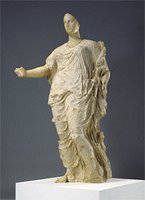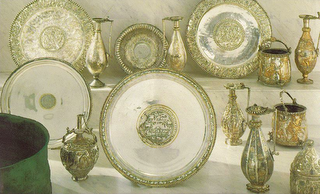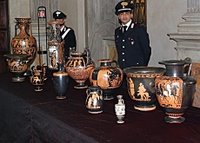
The New York Times
devoted a short brief on the so-called Getty trial wednesday. After a long summer hiatus, the trial of former
Getty Museum curator Marion True and art dealer Robert Hecht
continued Wednesday in Rome, with the testimony of Fausto Guarnieri, who once worked for Italy's art-theft squad. The statue is only on e of the objects at issue in the prosecution of True and Hecht, who are accused of dealing in stolen artifacts. A 1939 Italian law vests title to all unearthed antiquities in the State.
The statue of Aphrodite, pictured here, was purchased for $18 million by the Getty in 1988. It dates from the 5th century BC, near a Greek settlement in Sicily known as
Venere di Morgantina. Italian authorities were alerted in 1986 by rival looters, who were angry that the statue had been sold too cheaply. Guarnieri testified that 20 years ago tomb robbers led him to a site in Sicily where the statue had been unearthed.
The trial is a tremendous black eye for the Getty, as the sculpture is a centerpiece of the museum's antiquities collection in Malibu. True's defense counsel are arguing that the sale of the statue was met with little official interest by Italian authorities in 1988 when the sale took place. Apparently, the statue was not on the official list of stolen objects when the Getty made official inquiries at the time of the sale. It would have been difficult though, as there was no record of what the statue actually looked like. Prosecutors are relying on scientific data which points to the statue's origin in Morgantina.
This trial will of course be watched very closely by museums all over the world with Italian antiquities. Though I failed to grasp it when I posted comments about the decision by the Museum of Fine arts in Boston's
decision to return 13 antiquities to Italy, the True prosecution may have been at least part of the impetus behind the decision. Also, New York's Metropolitan Museum of Art recently returned 21 pieces to Italy.
I'm not sure what this prosecution means for the illicit trade. Certainly, it seems likely that museums will be far more careful when they acquire Italian antiquities. However, it seems likely that the looters will continue their work, they just will sell to dealers and individuals rather than museums. Is the public good being served by having these objects in the hands of an individual rather than a museum? Perhaps not; but however nefarious we might believe the actions of True and Hecht were in this case, wasn't there a tremendous value in allowing the public to view these objects? Its the same kind of argument that Greece and the British Museum have been fighting over for centuries in relation to the Parthenon Sculptures/Elgin Marbles. There are no clear answers. However, the Parthenon Sculptures have been resting in London for centuries now, while the Italian antiquites are a fairly recent acquisition by the Getty. Conversely, the archaeological context was lost when the statue was unearthed twenty years ago. However, was there anything in that soil record about Greek civilization that we don't already know? We can't be sure. At the very least, the idea of a museum acquiring a very valuable object which had been looted strikes me as distasteful. It certainly reveals a troubling part of museum acquisition which I suspect the vast majority of visitors are unaware of.
What is certain, is that Italian authorities are pursuing an aggressive policy of pursuing antiquities found/looted/unearthed within its borders. This will likely diminish the prices which sellers of certain questionable objects can expect to receive for their finds in the short-term. But it might increase the price which may be paid for objects with a clean provenance. An unintended consequence may be the decrease in opportunities for visitors and residents California, Boston, and New York to see these examples of Greek and Roman culture.
Perhaps the way forward is an increase in travelling exhibitions, but there are financial, logistical and other drawbacks to that remedy as well. The one thing all parties involved in this prosecution, and the wider debate can certainly agree on, is that these are extremely valuable and beautiful objects.


















